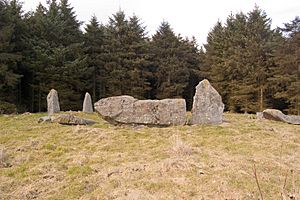Aikey Brae stone circle facts for kids

View of circle with recumbent in centre
|
|
| Location | Scotland |
|---|---|
| Region | Aberdeenshire |
| Coordinates | 57°30′50″N 2°04′13″W / 57.5140°N 2.0704°W |
| Type | Recumbent stone circle |
| Site notes | |
| Public access | Yes |
| Designated | 1925 |
| Identifiers | |
| Historic Environment Scotland | SM2 |
Aikey Brae is a special stone circle located on Parkhouse Hill. It is found near the town of Old Deer in Aberdeenshire, Scotland. This ancient site is known for its very large stone, called a "recumbent stone," which lies flat. This stone weighs about 21.5 tonnes! There are five stones still standing at Aikey Brae today. It is a scheduled monument, which means it's a protected historical site.
What are Recumbent Stone Circles?
A recumbent stone circle is a unique type of stone circle. These circles were built a very long time ago, during the early Bronze Age.
The main feature of these circles is a huge stone called the recumbent stone. This stone is always laid down flat. It is usually placed so its longest side points towards the south or southwest. On each side of the recumbent stone, there are two tall stones called flanker stones. These are often the tallest stones in the whole circle.
The other stones in the circle usually get smaller as you move away from the recumbent stone. The smallest stones are often on the northeast side. Most circles have between six and ten standing stones in total.
Builders of these circles often chose spots on hills that had great views. More than seventy of these circles are found in northeast Scotland, especially in Aberdeenshire. Similar circles are also found in southwest Ireland.
Inside these stone circles, there was often a low mound of stones, called a ring cairn. Over many years, these mounds have often disappeared. We don't know the exact reason why these circles were built. However, archaeologists have found cremated human remains at some sites.
Aikey Brae Up Close
Aikey Brae is also known as the Parkhouse Hill stone circle. It sits at the very top of Parkhouse Hill.
Today, five stones are still standing at Aikey Brae, including the massive recumbent stone. Five other stones have fallen over time. The recumbent stone is one of the biggest in Aberdeenshire. It weighs around 21.5 tonnes, which is like the weight of several elephants!
The entire stone circle is quite wide, measuring between 15 and 16.5 meters across. It is also surrounded by a raised bank of earth. In late 2019, some trees next to the site were cut down.
Aikey Brae's Story
Aikey Brae became a scheduled monument in 1925. This means it is a very important historical site that is protected by law.
In the 1980s, researchers like Clive Ruggles and Aubrey Burl studied Aikey Brae. They looked at how the stones might have lined up with the sun, moon, or stars. This study is called archaeo-astronomy.
Later, in 2001, archaeologists Chris Ball and Richard Bradley dug up parts of the site. They made some interesting discoveries. They found that the stones forming the ring bank around the circle were placed in a pattern of red and white stones.
They also found some ancient tools and items. These included 43 pieces of worked stone, flakes of quartz, and flint scrapers. Based on their findings, it seems that Aikey Brae was built all at once, rather than slowly over many years like some other stone circles.

